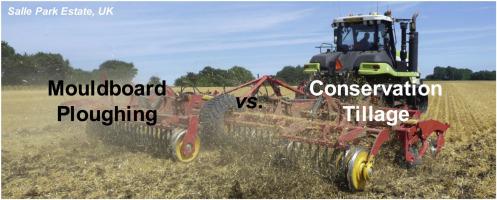Soil and Tillage Research ( IF 6.5 ) Pub Date : 2020-05-08 , DOI: 10.1016/j.still.2020.104648 Richard J. Cooper , Zanist Q. Hama-Aziz , Kevin M. Hiscock , Andrew A. Lovett , Emilie Vrain , Stephen J. Dugdale , Gisela Sünnenberg , Trudie Dockerty , Poul Hovesen , Lister Noble

|
In 2010, the UK government launched the Demonstration Test Catchments (DTC) platform to evaluate the extent to which on-farm mitigation measures can cost-effectively reduce the impacts of agricultural water pollution on river ecology whilst maintaining food production capacity. In this paper, we compare the impacts on soil health of two types of conservation tillage (direct drill and shallow non-inversion) against conventional mouldboard ploughing after five years (2013–2018) of adoption within the River Wensum DTC. Across the 143 ha conservation tillage trial area, temporal changes in the physical, chemical and biological condition of the soils were examined through the analysis of 324 soil samples, whilst the impacts on soil water chemistry were assessed through the analysis of 1176 samples of subsurface field drainage. Riverine water pollution was also explored through high-resolution (30 min) hydrochemistry measurements generated by an automated, in-situ bankside monitoring station located 650 m downstream of the trial area. Results revealed that conservation tillage did not significantly alter the soil physical, chemical or biological condition relative to conventional ploughing during the first five years. In addition, conservation tillage did not reduce nutrient leaching losses into field drainage and did not significantly impact upon river water quality, despite the trial area covering 20% of the catchment. Economically, however, conservation tillage yielded net profit margins 13% higher than conventional ploughing after five years of practice due to a combination of operational efficiency savings and improved yields. Overall, the results of this study demonstrate that conservation tillage alone is ineffective at improving the short-term environmental sustainability of farming practices in this lowland intensive arable setting and indicates that a broader, integrated approach to conservation agriculture is required incorporating aspects of cover cropping, crop rotations and precision farming techniques. The improvements in farm business performance do, however, demonstrate land managers can make important financial gains by converting to a conservation tillage system.
中文翻译:

保护性耕作和土壤健康:英国5年农场试验的经验教训(2013–2018)
2010年,英国政府启动了示范试验集水区(DTC)平台,以评估农场缓解措施可以在多大程度上经济有效地减少农业用水污染对河流生态的影响,同时又保持食品生产能力。在本文中,我们比较了在文苏姆河DTC中采用五年(2013-2018年)后传统的翻板耕作对两种保护性耕作(直接钻探和浅层非反转)对土壤健康的影响。在143公顷的保护性耕作试验区中,通过分析324个土壤样品来研究土壤的物理,化学和生物学状况的时空变化,同时通过分析1176个地下田地样品来评估对土壤水化学的影响。引流。原位位于试验区下游650 m的河岸监测站。结果表明,相对于传统耕作,在最初的五年中,保护性耕作不会显着改变土壤的物理,化学或生物状况。此外,尽管试验区覆盖了集水区的20%,但保护性耕作并没有减少养分流失到田间排水中的损失,也没有显着影响河流水质。但是从经济上讲,由于节省了运营效率并提高了产量,经过五年的实践,保护性耕作的净利润率比传统耕作高13%。总体,这项研究的结果表明,在这种低地集约化耕作环境中,仅保护性耕作无法有效改善耕作方式的短期环境可持续性,并表明需要一种更广泛的,综合性的保护性农业方法,包括覆盖性耕作,轮作等方面和精密耕作技术。但是,农场经营绩效的提高确实表明,土地管理者可以通过转换为保护性耕作制度来取得重要的经济收益。



























 京公网安备 11010802027423号
京公网安备 11010802027423号